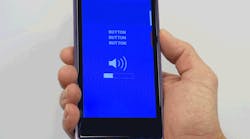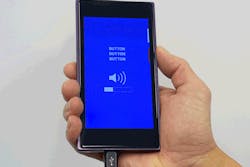Sentons is aiming to change the way we interact with smartphones, as well as other products like tablets, wearables, and laptops, thanks to the recent launch of its SurfaceWave processor and proprietary “Gesture Engine.” The company’s goal is to bring software-defined-surfaces (SDS) technology to every glass, plastic, and metal surface by combining its ultrasonic touch-sensing technology and ultrasonic strain-gauge force sensors.
According to Sentons, integrating ultrasonic sensing technologies into consumer-electronics products enables any surface to become a programmable touch interface, or SDS. The company maintains that manufacturers of devices, such as mobile phones and wearables, can take advantage of its platform to create software-defined interactions that extend beyond the unchangeable physical buttons and touchscreens familiar to users. Sentons has already created a developer phone that incorporates the company’s technology (see figure).
Technology developed by Sentons makes it possible to build a smartphone without physical buttons. Here, the volume can be adjusted with virtualized buttons rather than actual physical versions.
The patented SurfaceWave technology can create “smart” interfaces out of surfaces of any shape, material, and size. The company says that it has “rolled all key pieces of the technology into highly integrated custom application-specific integrated circuits (ASICs), making it easy for original equipment manufacturers (OEMs) to integrate the solutions into their products.” The result, according to Sentons, is a fast time-to-market, a minimal number of external components, and streamlined manufacturing processes.
With the SurfaceWave processor, all interactions with a surface can be interpreted as waves and processed for location, intention, and force. The SurfaceWave processor works with Sentons’ Gesture Engine and sensor modules. The sensor modules enable ultrasonic sensing via small, low-cost transducers attached to the backside of any surface.
The Gesture Engine, which is featured in all Sentons processors, allows for reduced latency and increased responsiveness. It also unlocks enhanced interaction capabilities. In addition, the firmware stack is self-learning and adaptable. Thus, the technology is able to recognize and adapt to changes in the state of the device, including permanent dents or scratches in the bezel, cracks on the screen, etc.
The Gesture Engine also improves on the capability to recognize more complex and precise gestures. For example, the technology can detect whether a touch is intentional, discern between light and forceful interactions, and even determine which hand is holding the device.
By equipping mobile devices with Sentons’ technology, buttons can be replaced entirely with virtualized buttons, either permanently or on-demand. The technology also ties into photography—rather than having to tap on the screen and drag a zoom wheel, users would be able to zoom in and out by simply sliding a finger along the top of the device. Gaming represents another scenario; Sentons collaborated with Asus and Tencent to create the ROG II, a new gaming phone that features “air triggers.” These air triggers are software-defined virtual buttons that enable the phone to be used like a video game controller.
Sentons was founded in 2011 and currently has about 50 employees. The company is venture-backed and has raised $37.7 million in funding. Headquartered in San Jose, Calif., Sentons also has other facilities in Taiwan, China, and South Korea. Its technology is now available to any mobile manufacturer and can be integrated with nearly any form factor or surface material.


